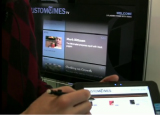In the last couple of weeks, we’ve seen significantly more people reporting they’ve seen AdWords that allow advertisers to collect email addresses directly in the ad unit. Now Google has confirmed it has expanded the trial of the lead generation format to additional advertisers.
We’ve seen the format used by daily deal provider bloomspot, which also collected ZIP codes via the form, presumably to add subscribers to the appropriate city-specific deals newsletters. Email service providers like AWeber and Vertical Response also seem to be trying out the format. Previous versions of the test included the ability for users to request phone calls from marketers, as well.
A Google spokesperson sent a statement reading: “This ad format is still in testing phase, but our team is getting a lot of interest from advertisers and we’ve been slowly expanding the trial over recent months. These ads help businesses gather new leads and enable users to easily get relevant information and ask for quotes.”
Indeed, the format seems designed for marketers peddling high-consideration goods or services, which often require significant nurturing and follow-up by a salesperson. On the consumer side, one could seem them being useful for car manufacturers and retailers, and business-to-business leads seem a natural use case
The New York Times Company Research & Development Lab works to innovate around new technologies, anticipating consumer behaviors and building new interfaces for news
We know what you’re thinkingIMAGINE browsing a website when a saucy ad for lingerie catches your eye. You don’t click on it, merely smile and go to another page. Yet it follows you, putting up more racy pictures, perhaps even the offer of a discount. Finally, irked by its persistence, you frown. “Sorry for taking up your time,” says the ad, and promptly desists from further pestering. Creepy. But making online ads that not only know you are looking at them but also respond to your emotions will soon be possible, thanks to the power of image-processing software and the ubiquity of tiny cameras in computers and mobile devices.
Uses for this technology would not, of course, be confined to advertising. There is ample scope to deploy it in areas like security, computer gaming, education and health care. But admen are among the first to embrace the idea in earnest. That is because it helps answer, at least online, clients’ perennial carp: that they know half the money they spend on advertising is wasted, but they don’t know which half.
Advertising firms already film how people react to ads, usually in an artificial setting. The participants’ faces are studied for positive or negative feelings. A lot of research, some of it controversial, has been done into ways of categorising the emotions behind facial expressions. In the 1970s Paul Ekman, an American psychologist, developed a comprehensive coding system which is still widely used.
Some consumer-research companies also employ goggle-mounted cameras to track eye movements so they can be sure what their subjects are looking at. This can help determine which ads attract the most attention and where they might be placed for the best effect on a web page.
This work is now moving online. Higher-quality cameras and smarter computer-vision software mean that volunteers can work from home and no longer need to wear clunky headgear. Instead, their eyes can be tracked using a single webcam.
One of the companies doing such work, Realeyes, which is based in London, has been developing a system that combines eye-spying webcams with emotional analysis. Mihkel Jäätma, who founded the company in 2007, says that his system is able to gauge a person’s mood by plotting the position of facial features, such as eyebrows, mouth and nostrils, and employing clever algorithms to interpret changes in their alignment—as when eyebrows are raised in surprise, say. Add eye-movement tracking, hinting at which display ads were overlooked and which were studied for any period of time, and the approach offers precisely the sort of quantitative data brand managers yearn for.
At present the system is being used on purpose-built websites with, for instance, online research groups testing the effect of various display ads. The next step is to make interactive ads. Because they can spot the visual attention given to them, as well as the emotional state of the viewer, these ads could tailor their responses.
As similar gimmicks become widespread, privacy concerns will invariably mount. People would need to give consent to their webcams being used in this way, Mr Jäätma admits. One way to persuade internet users to grant access to their images would be to offer them discounts on goods or subscriptions to websites.
Realeyes is also working with Kaplan, an educational-services company, on a project in Hungary which is using the system to measure how children respond to virtual games that teach them English. The hope is that by performing the same emotion-reading trick that marketers use, the type of tasks and the characters that appear in them can be made more engaging.
The technology would make computer games more engaging, too. Sony, for one, thinks that reading players’ emotions with webcams would let software pick up on their subconscious behaviour and change the game in ways that would enhance the experience. The company claims that in the future it will be possible to have something like a detective game in which the camera can read players’ faces and measure their heart rates in order to have a stab at deciding which ones are lying.
In fact, webcams that monitor a person’s heart rate are soon to appear. Instead of sticking sensors onto the skin, Philips has developed a vital-signs camera system which the Dutch company says can measure heart and respiration rates extremely accurately. To calculate the heart rate the camera detects tiny changes in the colour of the skin. These changes, imperceptible to the human eye, occur as the heart pumps blood through the body. The person’s breathing rate is measured by detecting the rise and fall of his chest. The firm will soon launch an app for Apple’s iPad 2 which will allow people to measure their own heart and breathing rates using the two webcams in that device.
Philips is developing the technology as a contactless system to keep a virtual eye on hospital patients, such as newborn babies, who might find conventional monitors distressing. The company is also eyeing anxious parents who always want to know what their tots are up to, as well as anxious coaches and their athletes. Advertising firms will, no doubt, be just as keen to measure heartbeats, especially for ads designed to get pulses racing. Those who find it all smacks of Big Brother can turn their webcams off. If you are playing online poker, that is probably a wise idea.
Webcams can now spot which ads catch your gaze, read your mood and check your vital signs...
Google is opening wider a beta test of Dynamic Search Ads, an interesting new type of AdWords ad for larger advertisers that eliminates the need for keywords.
With this ad type, designed for retailers or other advertisers with large, often-changing inventory, Google automatically generates ad copy — based on the advertiser’s template — by looking at the content in the advertiser’s Web site. Google also automatically displays the ad in response to search terms it thinks are a good match, without the advertiser having to select keywords. Google has been using a similar no-keywords approach in its program for small local advertisers, AdWords Express.
For Dynamic Search Ads, advertisers input their Web site URL or the URL of a range of pages on their site — say, a retailer wanted to promote their women’s clothing — and select a bid price based on the value of that category to them. Google then continually crawls the Web site so it knows when inventory changes, and can theoretically respond with relevant ads more quickly than the marketing team that’s manually creating keywords and ads. The system is also designed to keep on top of changes in the types of queries people are performing — Google says 16% of searches every day are new.
In an effort to keep this from impinging on advertisers’ existing campaigns, the system will hold back the dynamically generated ad in favor of advertiser-created copy, if the advertiser already has a campaign targeting the specific search term.
“We want to make sure it doesn’t affect keyword campaigns,” Baris Gultekin, director of AdWords product management, told me. “This is purely incremental.”
Gultekin says the company will provide advertisers with reporting on search terms that generated clicks, the matched destination pages and ad headlines generated, average CPC, clicks and conversions. Advertisers may optimize by adjusting a max CPC bid.
The new ad type has been in development for two and a half years, and “a couple hundred” advertisers across a variety of verticals have already been testing it. Gultekin says advertisers on average are seeing 5-10% increase in conversions with a positive ROI.
One advertiser in particular — ApartmentHomeLiving.com, a real estate Web site with constantly changing inventory — says it saw a 50% increase in conversions at an average cost-per-conversion that’s 73% less than their normal search ads. The company is already a seasoned search marketer with campaigns of up to 15 million keywords.
Dynamic Search Ads are available in all languages and all countries currently, but only to advertisers in the limited beta. The company is soliciting inquiries from customers that might be interested in participating in the beta in order to widen its reach.

Online advertising is a remarkably complex field. Terence Kawaja has a new way for potential investors to visualize it.
The market involves hundreds of small and large companies that help advertisers reach consumers and help website publishers, mobile-application developers, search engines and other digital destinations generate revenue through advertising.
Kawaja, who runs boutique investment firm LUMA Partners, spent months putting together six new graphics that show how 1,240 different companies fit into the following categories of online advertising: display, video, search engines, mobile, social, and commerce. (See slides below, or click here for the LUMA site.)
The graphics, Kawaja says, help “large strategic acquirers” such as Google, Yahoo and Adobe to identify possible targets of acquisition.
Kawaja, well-known in the online advertising industry, rose to greater prominence after publishing a graphic in 2009 that attempted to make sense of one particularly fragmented aspect of online advertising: the market for graphical, interactive and video ads, a category known as display, which generated $10 billion in U.S. spending last year, according to eMarketer. The graphic became an important tool used by online ad executives.
For instance, after the graphic was published Kawaja represented Invite Media in its acquisition by Google last year. (Invite allows advertisers to buy ads through digital exchanges that match websites with advertisers, known in the industry as a demand-side platform).
Kawaja’s 2011 graphic on the display-ad market includes newcomers such as TellApart, which helps advertisers do what’s called “retargeting,” or showing graphical ads to Internet users for products they previously expressed interest in. The new “social” graphic lists the companies such as Vurve and Efficient Frontier that help marketers advertise on Facebook, Twitter and other social-networking-type sites such as LinkedIn and Loopt.
The graphics, which Kawaja is branding as “LUMAscapes,” will evolve as he receives feedback about other companies that should make the cut. Some ad executives say the graphics will be a point of discussion during this week’s Digital Media Summit, a gathering of chief executives of private Internet companies as well as investors in New York.
Check below for the full list of new graphics, and click on the images for the larger version.















